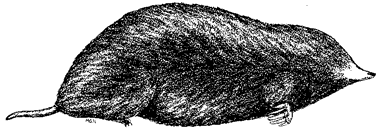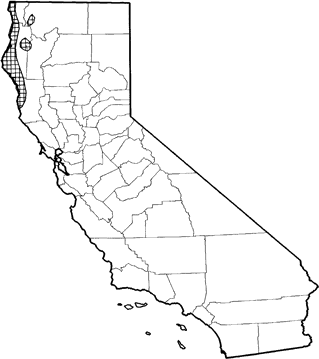
Coast Mole
Distribution, Abundance, and Seasonality
The coast mole is uncommon to common in humid regions of Del Norte, Humboldt, and Mendocino cos. Optimal habitats are wet meadow, annual and perennial grassland, montane riparian, and early successional stages of redwood, Douglas-fir, mixed conifer, and montane hardwood-conifer forests.

Range Map
Specific Habitat Requirements
Feeding: The diet consists of 56-93% earthworms, 16-28% insects, as well as centipedes, millipedes, small mammals, snails, and slugs (Moore 1933, Glendenning 1959, Whitaker et al. 1979). May eat nearly twice its weight in worms daily. Forages just below the ground surface, and may make surface runways under snow.
Cover: Like other moles, the coast mole is almost entirely subterranean, living in a system of shallow burrows.
Reproduction: Nests in a cavity 15 cm (6 in) below the surface, in areas protected from flooding and surface disturbances. Nests may be buried under brush, tree roots, old buildings, or along fence rows. Nests are lined with coarse grass.
Water: Sufficient water is obtained from food, particularly earthworms.
Pattern: Prefers light, moist, friable soils, but will burrow in sand or gravel. Uses dense woods and brush with a dense litter layer to a greater extent than Townsend's mole. The number of molehills is related to soil bulk-density, water content and abundance of worms (Schaefer and Sadleir 1981). Flooding lowers the density of this species.
Species Life History
Activity Patterns: Active yearlong, at any time of day or night, but most activity is diurnal. More active in winter months, presumably because soil is wetter and looser.
Seasonal Movements / Migration: Moles may move away from cultivated fields or flooded areas.
Home Range: Home range estimates include 0.4 ha (1 ac) (Glendenning 1959) and 0.03 ha (0.07 ac) (Schaefer 1982).
Territory: Glendenning (1959) reported territory size of 0.1 ha (0.25 ac). Probably defends all, or a portion, of the burrow system.
Reproduction: Mates during January to March Young are born in March and April. The single yearly litter usually consists of 3-4 young. Litter size increases with age of the female, from 2 (yearlings) to 4 (more than 2 years old). Young leave the nest in May. Six percent of individuals lived to 3 yr (Glendenning 1959).
Niche: This mole prefers forest to a greater extent than Townsend's mole. Predators include rubber boas, owls, cats, and dogs (Maser et al. 1981).
Sources & References
California Department of Fish and Game, 1999.
California's Wildlife, Sacramento, CA.
Written by: G. Hoefler, J. Harris, reviewed by: H. Shellhammer, edited by: S. Granholm
Glendenning, R. 1959. Biology and control of the coast mole, Scapanus orarius orarius True, in British Columbia. Can. J. Anim. Sci. 39:34-44. Maser, C., B. R. Mate, J. F. Franklin, and C. T. Dyrness. 1981. Natural history of Oregon coast mammals. Pac. Northwest For. And Range Exp. Sta., USDA, For. Serv., Gen. Tech. Rep., PNW-133. 496pp. Moore, A. W. 1933. Food habits of Townsend's and coast moles. J. Mammal. 14:36-40. Nowak, R. M., and J. L. Paradiso. 1983. Walker's mammals of the world. 4th ed. 2 vols. John Hopkins Univ. Press, Baltimore, MD. 1362pp. Schaefer, V. H. 1982. Movements and diel activity of the coast mole, Scapanus orarius True. Can. J. Zool. 60:480-482. Schaefer, V. H., and R. M. F. S. Sadlier. 1981. Factors influencing molehill construction by the coast mole (Scapanus orarius). Mammalia 45:31-38. Whitaker, J. O., Jr., and C. Maser, and R. J. Pedersen. 1979. Food and ectoparasitic mites of Oregon moles. Northwest Sci. 53:268-273.
California Animal Facts | California's Wildlife